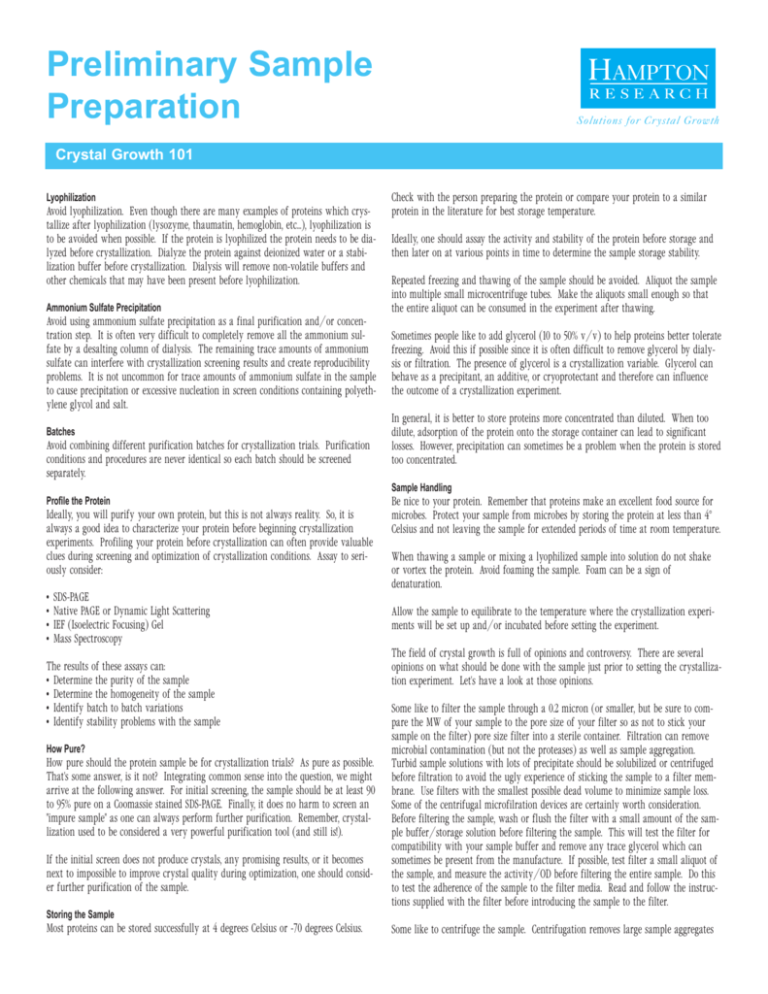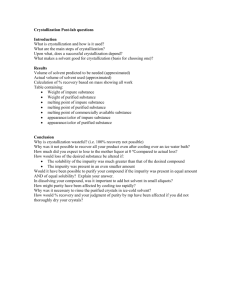
Preliminary Sample
Preparation
Solutions for Cr ystal Growth
Crystal Growth 101
Lyophilization
Avoid lyophilization. Even though there are many examples of proteins which crystallize after lyophilization (lysozyme, thaumatin, hemoglobin, etc...), lyophilization is
to be avoided when possible. If the protein is lyophilized the protein needs to be dialyzed before crystallization. Dialyze the protein against deionized water or a stabilization buffer before crystallization. Dialysis will remove non-volatile buffers and
other chemicals that may have been present before lyophilization.
Ammonium Sulfate Precipitation
Avoid using ammonium sulfate precipitation as a final purification and/or concentration step. It is often very difficult to completely remove all the ammonium sulfate by a desalting column of dialysis. The remaining trace amounts of ammonium
sulfate can interfere with crystallization screening results and create reproducibility
problems. It is not uncommon for trace amounts of ammonium sulfate in the sample
to cause precipitation or excessive nucleation in screen conditions containing polyethylene glycol and salt.
Batches
Avoid combining different purification batches for crystallization trials. Purification
conditions and procedures are never identical so each batch should be screened
separately.
Profile the Protein
Ideally, you will purify your own protein, but this is not always reality. So, it is
always a good idea to characterize your protein before beginning crystallization
experiments. Profiling your protein before crystallization can often provide valuable
clues during screening and optimization of crystallization conditions. Assay to seriously consider:
•
•
•
•
SDS-PAGE
Native PAGE or Dynamic Light Scattering
IEF (Isoelectric Focusing) Gel
Mass Spectroscopy
The results of these assays can:
• Determine the purity of the sample
• Determine the homogeneity of the sample
• Identify batch to batch variations
• Identify stability problems with the sample
How Pure?
How pure should the protein sample be for crystallization trials? As pure as possible.
That's some answer, is it not? Integrating common sense into the question, we might
arrive at the following answer. For initial screening, the sample should be at least 90
to 95% pure on a Coomassie stained SDS-PAGE. Finally, it does no harm to screen an
"impure sample" as one can always perform further purification. Remember, crystallization used to be considered a very powerful purification tool (and still is!).
If the initial screen does not produce crystals, any promising results, or it becomes
next to impossible to improve crystal quality during optimization, one should consider further purification of the sample.
Storing the Sample
Most proteins can be stored successfully at 4 degrees Celsius or -70 degrees Celsius.
Check with the person preparing the protein or compare your protein to a similar
protein in the literature for best storage temperature.
Ideally, one should assay the activity and stability of the protein before storage and
then later on at various points in time to determine the sample storage stability.
Repeated freezing and thawing of the sample should be avoided. Aliquot the sample
into multiple small microcentrifuge tubes. Make the aliquots small enough so that
the entire aliquot can be consumed in the experiment after thawing.
Sometimes people like to add glycerol (10 to 50% v/v) to help proteins better tolerate
freezing. Avoid this if possible since it is often difficult to remove glycerol by dialysis or filtration. The presence of glycerol is a crystallization variable. Glycerol can
behave as a precipitant, an additive, or cryoprotectant and therefore can influence
the outcome of a crystallization experiment.
In general, it is better to store proteins more concentrated than diluted. When too
dilute, adsorption of the protein onto the storage container can lead to significant
losses. However, precipitation can sometimes be a problem when the protein is stored
too concentrated.
Sample Handling
Be nice to your protein. Remember that proteins make an excellent food source for
microbes. Protect your sample from microbes by storing the protein at less than 4°
Celsius and not leaving the sample for extended periods of time at room temperature.
When thawing a sample or mixing a lyophilized sample into solution do not shake
or vortex the protein. Avoid foaming the sample. Foam can be a sign of
denaturation.
Allow the sample to equilibrate to the temperature where the crystallization experiments will be set up and/or incubated before setting the experiment.
The field of crystal growth is full of opinions and controversy. There are several
opinions on what should be done with the sample just prior to setting the crystallization experiment. Let's have a look at those opinions.
Some like to filter the sample through a 0.2 micron (or smaller, but be sure to compare the MW of your sample to the pore size of your filter so as not to stick your
sample on the filter) pore size filter into a sterile container. Filtration can remove
microbial contamination (but not the proteases) as well as sample aggregation.
Turbid sample solutions with lots of precipitate should be solubilized or centrifuged
before filtration to avoid the ugly experience of sticking the sample to a filter membrane. Use filters with the smallest possible dead volume to minimize sample loss.
Some of the centrifugal microfilration devices are certainly worth consideration.
Before filtering the sample, wash or flush the filter with a small amount of the sample buffer/storage solution before filtering the sample. This will test the filter for
compatibility with your sample buffer and remove any trace glycerol which can
sometimes be present from the manufacture. If possible, test filter a small aliquot of
the sample, and measure the activity/OD before filtering the entire sample. Do this
to test the adherence of the sample to the filter media. Read and follow the instructions supplied with the filter before introducing the sample to the filter.
Some like to centrifuge the sample. Centrifugation removes large sample aggregates
Preliminary Sample
Preparation
Solutions for Cr ystal Growth
Crystal Growth 101
and amorphous debris. Post centrifugation views can provide a visual clue of aggregation/precipitate for seemingly clear solutions. Following centrifugation use only
the supernatant for crystallization trials.
Others prefer to avoid filtration or centrifugation before setting crystallization experiments. One view is that the presence of amorphous material or aggregates can
enhance the changes for crystallization be acting as nucleants.
To Azide or Not
Sodium azide (NaN3) is an anti-microbial preservative that is sometimes used to protect samples and crystallization reagents from microbial contamination. Sodium
azide is toxic and should be handled with care. Typical sodium azide concentrations
are 1 mM or if you prefer % measurements, between 0.02% and 0.1% w/v.
If you choose to use sodium azide remember that:
• It is toxic to humans as well as microbes.
• It is an inhibitor for some proteins and may become an unintentional ligand for
your sample.
• It can interfere with heavy atom derivatization.
• Some metal azides are explosive.
• There are reports where eliminating sodium azide from the experiment improved
crystallization.
Alternatives to sodium azide include thymol and Thimerosal.
A final alternative to the use of antimicrobials is the use of proper sterile technique
and materials. Sterile filter all samples and reagents into sterile containers. Store
samples and reagents at 4 degrees Celsius or lower. Use sterile pipet tips. Keep your
work area clean. Develop a sterile technique with your crystallization set ups. With
common sense, sterile reagents and sample, good technique, and sterile pipet tips, one
can successfully avoid the use of chemical antimicrobials in the crystallization lab.
Label & Organize Samples
Label samples clearly with the sample identification, batch identification, and date of
storage. Here small cryo labels can be very useful. Color coding samples can be a
nice organization tool. For the sake of easy organization and identification it is
sometimes more convenient to nest samples. For example, store batches of small
microcentrifuge tubes in 10 ml of 50 ml centrifuge tubes and organize them by batch
or sample.
2
• Date
• Person performing experiment
Questions to Ponder About the Sample
• Does a similar sample exist and has it been crystallized?
• Does the sample contain free cysteines?
• Does the sample contain additives such as sodium azide, ligands, inhibitors, or substrates?
• Is the protein glycosylated?
• Is the protein phosphorylated?
• Is the protein N-terminal methylated?
• At what temperature is the protein stable?
• How does sample solubility and stability change temperature?
• How does sample solubility and stability change with pH?
• Does the sample bind metals?
• Is the protein sensitive to proteolysis?
• What class of protein am I working with (antibody, virus, enzyme, membrane
protein)?
• What have been the most successful approaches with my class of protein?
• What is the source of the sample?
• How was the sample purified and stored before it arrived into my hands?
• What is in the sample container besides the sample (buffer, additives, etc...)?
• Is the sample pooled purification aliquots or a single batch?
• How much sample do I have and how much more is available?
• How pure is the sample?
• How homogeneous is the sample?
• Does anyone possess any solubility information on this sample?
• What is unique about this protein?
• What is necessary chemically and physically to maintain a stable active sample?
Technical Support
Inquiries regarding preliminary sample preparation, interpretation of screen results,
optimization strategies and general inquiries regarding crystallization are welcome.
Please e-mail, fax, or telephone your request to Hampton Research. Fax and e-mail
Technical Support are available 24 hours a day. Telephone technical support is available 8:00 a.m. to 5:00 p.m. USA Pacific Standard Time.
It is prudent to write down and hold onto detailed notes concerning the purification,
storage, and handling of the sample. It is obvious that one should also maintain
records of crystallization trials which should include:
•
•
•
•
•
•
•
•
•
•
Sample Information
Name of sample
Sample identification (batch, storage location, storage temperature, etc...)
Sample buffer composition, additives, ligands, etc...
Sample concentration
Crystallization Experiment Information
Method
Drop size and composition
Reagent composition
Temperature
Hampton Research
27632 El Lazo Road, Suite 100
Laguna Niguel, CA 92677-3913 U.S.A.
Tel: (949) 425-1321 • Fax: (949) 425-1611
Technical Support e-mail: tech@hrmail.com
Internet: www.hamptonresearch.com
© 2001 Hampton Research Corp. all rights reserved
Printed in the United States of America. This guide or
parts thereof may not be reproduced in any form without
the written permission of the publishers.






